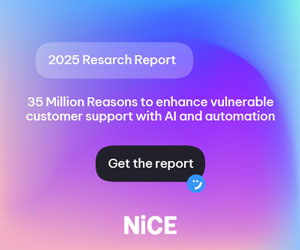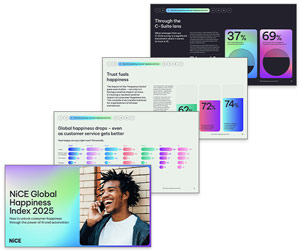Your customer service isn’t as effective as you think, according to a NICE inContact survey that shows gaps between business and consumer perceptions.
The results of a study compare how businesses rate their success across more than 10 customer experience channels versus the actual experience and satisfaction that customers report in those channels.
The new research, the second wave of the NICE inContact Customer Experience Transformation Benchmark Study, analyses how customer service organisations think they are delivering in both agent-assisted and self-service channels.
This includes interactions with contact centre agents via phone, email, chat, social media, and text as well as through web self-service, mobile applications, and interactive voice response (IVR).
The research demonstrates a significant disconnect between how businesses perceive their customer service channels are performing and how consumers actually feel about the level of service they are receiving.
The gap in agent-assisted channels is 18 points between what businesses and consumers report, with businesses rating overall success for inbound/outbound calls, online chat/video, SMS text, and social mediaat 63%, whereas consumers give those same channels only 45% success rating. The biggest difference is with inbound/outbound voice calls at 28 points.
For self-service channels businesses report an overall success rate of 52% for customer satisfaction, yet consumers give only 39% success rating – a gap of 13 points.
Self-service channels included website, mobile app, automated phone menu, and virtual assistants (e.g. chatbots). For these channels, the biggest difference is with automated phone menu or interactive voice response (IVR), with a gap of 27 points.
The new research builds on the first wave of the customer experience study that revealed consumer responses published in April 2017. The NICE inContact second wave research surveyed businesses to gain insight into how they think they are meeting customer service needs, which channels businesses prefer to communicate through, and how satisfied businesses think their customers are with service experiences across channels.
The results confirmed that businesses are offering multiple channels to satisfy customers’ needs and preferences, as well focusing on being quick and providing complete information, regardless of channel.
“While both businesses and consumers agree that omnichannel options are essential for positive customer experiences, there is a clear divide in how successfully businesses are delivering those experiences across channels, and what priorities should be,” said Paul Jarman, CEO at NICE inContact.
“It’s imperative that businesses pay closer attention to consumer preferences and deploy technologies and strategies that best meet those needs – as quickly as possible, across all service channels.”
The Disconnect Between Businesses and Consumers
Online chat is viewed by consumers as the channel with the highest satisfaction rating – yet businesses rate chat as their least successful channel
Only 16% of businesses selected chat as one of their top three most preferred channels whereas 39% consumers placed online chat as one of their most preferred channels.
While phone calls and email are still preferred more highly by both business and consumers, chat represents an opportunity for businesses to meet consumers in a highly preferred channel.
For agent-assisted channels, businesses rate email a success despite low customer satisfaction
64% of businesses rate email a successful channel for customer interactions, while only 43% of consumers are satisfied when using that channel.
Major disconnect between how consumers and businesses rate mobile apps
Consumers most consistently rate mobile apps as the channel that elicits the most positive emotions for customer service.
Businesses, however, underestimate the impact, with mobile apps rated as one of the least likely to produce consumer positivity.
Businesses misaligned with customers on personalisation
21% of consumers studied rate personalised service as a top priority, compared to only 13% of businesses.
Where Businesses and Consumers Agree
Research shows agent-assisted phone calls are king, yet consumers still expect omnichannel options
Businesses believe they have the highest service resolution success rates with the phone (68%), and consumers reported preferring phone interactions too.
More than 50% of businesses offer all agent-assisted and self-service options (online chat/video, SMS, social media), even though most customers still heavily rely on phone calls for fastest resolution.
Speed is the highest priority for both customers and businesses
For self-service channels, both businesses and customers agree that fast resolution is the number-one priority for customer service. For agent-assisted, businesses prioritise providing the most complete information over speed, though customers still rate speed the top priority.
52% of consumers strongly agree – point them in the direction of fastest resolution
More than half of consumers expect companies to point them to the channel that will resolve the issue the fastest.
Businesses understand the importance of speed, too, with 51% strongly agreeing that this is key to consumers.
About the Report
NICE inContact surveyed 300 contact centre decision makers using a business panel for the Business Wave of the research.
For the Consumer Wave, NICE inContact surveyed more than 700 consumers who had experienced a customer service interaction in the past three months.
For more information, download the latest research report here or you can visit www.nice.com
Author: Robyn Coppell
Published On: 28th Sep 2017 - Last modified: 31st Jan 2018
Read more about - Industry News, NiCE, NiCE CXone



















